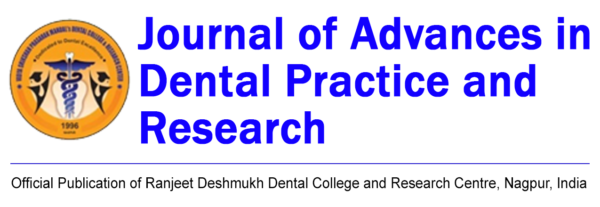Translate this page into:
Modified platysma myocutaneous flap technique for reconstruction of oral submucous fibrosis: A tehnical note
*Corresponding author: Simran Sangani, Department of Oral and Maxillofacial Surgery, VSPM DCRC, Nagpur, Maharashtra, India. simran.sangani@gmail.com
-
Received: ,
Accepted: ,
How to cite this article: Ingole P, Sangani S, Budhraja N, Shenoi R, Bang K. Modified platysma myocutaneous flap technique for reconstruction of oral submucous fibrosis: A tehnical note. J Adv Dental Pract Res 2022;1:76-7.
Abstract
Precancerous lesions, benign and malignant tumors, are the major causes for defects in the oral and maxillofacial region; hence, reconstruction of these defects emphasizes restoring the patient’s, form, function, and cosmetic appearance, thereby improving the quality of life. In our technique, we have used a modified technique by raising a superiorly based platysma myocutaneous flap through a single incision, rather than giving two incisions and we have increased the length of the pedicle for the reconstruction of patients with oral submucous fibrosis.
Keywords
Platysma flap
Oral submucous fibrosis
Reconstruction
INTRODUCTION
Precancerous lesions, benign and malignant tumors, are the major causes for defects in the oral and maxillofacial region; hence, reconstruction of these defects emphasizes restoring the patient’s, form, function, and cosmetic appearance, thereby improving the quality of life.[1] Over the years, numerous flaps have been proposed in the literature, for the reconstruction of these defects which include skin grafts, nasolabial flaps, palatal flaps, tongue flaps, buccal fat pad, and microvascular free flap each having its advantages and limitations. The platysma myocutaneous flap is versatile and has been used for oral maxillofacial reconstruction since 1978.[2] It has two designs – superiorly based and posteriorly based. The advantages of this versatile flap include a large donor area, proximity to the defect, great axial blood supply, and the skin pedicle of the platysma muscle can be easily harvested and rotated into the defect.[3] In our technique, we have modified the technique by raising a superiorly based platysma myocutaneous flap through a single incision, rather than giving two incisions and we have increased the length of the pedicle.
SURGICAL TECHNIQUE
The case is posted under general anesthesia, the neck is hyperextended, and the skin paddle is marked on the neck bilaterally, 4 cm above the superior border of the clavicle and approximately 4 × 5 cm in size [Figure 1]. The first dissection is carried over the superior limb of the flap done in supra-platysmal plane raising neck-skin subcutaneous flap until the lower border of the mandible through a single incision [Figure 2], then the incision is taken on the inferior limb of skin paddle and dissection is carried out in subplatysmal plane until the inferior border of the mandible, raising entire flap along with skin paddle, and long pedicle length to reach until retromolar trigone region. The platysma myocutaneous flap is then cut vertically keeping a broad base, for full mobilization of the flap. After this, intraorally a tunnel of the size of the pedicle is created from the buccal surface of the mandible into the neck at the lower border of the mandible and flap is transferred in the oral cavity which reaches until retromolar trigone with good pedicle length. The donor site is then sutured primarily in layers. In our modified technique for raising the platysma flap, we have avoided taking a second incision 2–3 cm inferior to the lower border of the mandible which is proposed in the literature for the ease of dissection and harvesting flap. The key features of this technique are as follows: (1) A single incision in the neck that hides in skin crease at the level of the lower neck (clavicular) region and (2) we get sufficient pedicle length with skin paddle to reach until retromolar trigone region in the oral cavity [Figure 3].

- Incision marking for the platysmal flap.

- Supra-platysmal dissection.

- Esthetic Closure.
Advantages
Multiple incisions are avoided using a single incision
A single scar line is noted, which hides in the clavicular region, giving better aesthetic results
Robust flap with good blood supply.
Disadvantages
It is technique sensitive
In female patient, meticulous dissection is needed due to thin platysma muscle.
CONCLUSION
The versatile platysma myocutaneous flap is a viable option for the reconstruction of intraoral defects due to its capability to yield optimal results functionally and esthetically.
Declaration of patient consent
The authors certify that they have obtained all appropriate patient consent.
Conflicts of interest
There are no conflicts of interest.
Financial support and sponsorship
Nil.
References
- Extended nasolabial flap compared with the platysma myocutaneous muscle flap for reconstruction of intraoral defects after release of oral submucous fibrosis: A comparative study. Br J Oral Maxillofac Surg. 2013;51:37-40.
- [CrossRef] [PubMed] [Google Scholar]
- Comparative evaluation of reconstructive methods in oral submucous fibrosis. J Maxillofac Oral Surg. 2021;20:597-606.
- [CrossRef] [PubMed] [Google Scholar]
- What is the optimal reconstructive option for oral submucous fibrosis? A systematic review and meta-analysis of buccal pad of fat versus conventional nasolabial and extended nasolabial flap versus platysma myocutaneous flap. J Maxillofac Oral Surg. 2020;19:490-7.
- [CrossRef] [PubMed] [Google Scholar]






